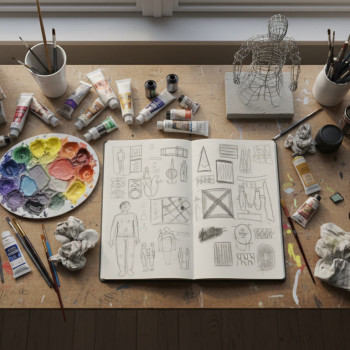Introduction: Why Cultural Comparison Matters for AP Students
If you’ve ever sat in a classroom watching the same historical event described by two different authors, or read a poem and wondered how its themes echo across cultures, you’ve already taken your first step toward cultural comparison. In AP classes—whether it’s AP World History, AP Literature, or AP Comparative Government—being able to draw meaningful parallels and contrasts across cultures is not just an academic exercise. It’s a skill that helps you think critically, write persuasively, and connect facts to human stories.

What Is Cultural Comparison?
At its heart, cultural comparison is the practice of examining how two or more societies, texts, or traditions handle similar issues—power, family, religion, economy, identity—and identifying both shared patterns and important differences. It’s more than listing facts. It’s about interpreting meaning, recognizing context, and showing why similarities or differences matter.
Key elements of effective cultural comparison
- Contextual awareness: Understand the historical, social, and political backdrop.
- Focused lens: Narrow your comparison to manageable themes (e.g., migration, gender norms, governance).
- Evidence-driven analysis: Use primary and secondary sources to support claims.
- Nuanced judgment: Avoid false equivalences—recognize complexity and exceptions.
Intro/Body/Bridge/Close: A Framework for Comparing Cultures (and Writing It Well)
Here’s a clean, exam-ready structure you can use for essays, DBQs, or long-form responses. Think of it as a roadmap: the Intro sets the stage, the Body builds the argument with examples, the Bridge connects the dots across cultures, and the Close deepens understanding and reflects on significance.
Intro: Plant the stakes and the scope
Begin with a sentence that quickly orients the reader—identify the two cultures or texts and the theme you’ll compare. Explain why this comparison matters. Use a clear thesis that previews both similarity and difference, or the directional argument you’ll make.
Body: Evidence, analysis, and structure
Organize the body into focused paragraphs, each with a mini-claim. Alternate between cultures or group paragraphs by theme depending on what makes your logic clearest. Always tether claims to evidence—quotations, statistics, policies, or primary-source descriptions—and explain how that evidence supports your point.
Bridge: Show relationship and implication
The bridge is where you synthesize. Don’t just list that Culture A had X and Culture B had Y—explain the relationship: Are the differences a result of geography, technology, religion, or political structures? What broader insight does this comparison reveal?
Close: Reflect and generalize
Conclude by reiterating the thesis in a deeper way: what larger understanding have you reached? A great close often considers consequence—what did these similarities or differences mean for people at the time, and why should a reader care now?
Example Walkthrough: Comparing Rituals of Coming-of-Age
To make the framework concrete, let’s compare two hypothetical coming-of-age practices: a communal rite of passage in Society A and a private, family-centered ritual in Society B. This mini-case demonstrates how to structure intro/body/bridge/close and how to weave context into analysis.
Intro (sample thesis)
Although both Society A and Society B mark the transition from childhood to adulthood with formal rituals, Society A’s public, communal ceremonies emphasize group cohesion and political roles, while Society B’s intimate family rituals stress lineage and moral education—differences rooted in each society’s social organization and historical pressures.
Body (how to present evidence)
- Paragraph 1: Describe Society A—public procession, communal vows, public responsibilities assigned. Use evidence: ceremonial texts, eyewitness descriptions.
- Paragraph 2: Describe Society B—household-only rituals, private mentorship, emphasis on household skills. Use evidence: family records, domestic manuals.
- Paragraph 3: Analyze a shared element—symbolic passage of objects—and show how the same object carries different meanings in each context.
Bridge
Connect the differences to broader social structures. For instance, Society A’s frequent external threats foster public unity rituals; Society B’s emphasis on kin-based property transmission produces private rites. This interpretation reveals how external pressures and internal organization shape cultural expression.
Close
End by reflecting on what these rites tell us about identity formation in human societies and propose a brief implication—perhaps how understanding these rituals helps modern multicultural societies negotiate public and private identities.
Tools and Techniques: How to Study and Prepare Efficiently
AP-level cultural comparison requires both content knowledge and craft. Below are practical methods to sharpen both.
Active reading and listing
- Annotate sources for theme, purpose, and audience.
- Create two-column notes: “Evidence” vs. “Possible Interpretations.”
- Summarize each source in one sentence to force clarity.
Comparative charts and matrices
Visual mapping helps you see patterns and exceptions at a glance. Create a table that lists cultural features, source evidence, and thematic implications.
| Feature | Society A (Evidence) | Society B (Evidence) | Interpretation |
|---|---|---|---|
| Ritual Type | Public procession (chronicle accounts) | Household ceremony (family letters) | Public vs. private orientation reflects civic vs. kinship priorities |
| Authority | Community elders officiate | Head of household officiates | Decentralized community authority vs. centralized household authority |
| Purpose | Integration into civic roles | Transmission of moral and domestic skills | State-building needs vs. preservation of lineage |
Practice prompts and timed writing
- Use past AP prompts or create your own: compare two texts/societies on a shared theme in 40–60 minutes.
- Time yourself and then annotate after: what was missing? Which transitions were weak?
Common Pitfalls—and How to Avoid Them
Even strong students fall into habitual errors. Recognizing these early will save you points on the AP exam.
Pitfall 1: Superficial comparison
Listing similarities without depth is a one-way ticket to mediocrity. Fix: Always ask “Why?” and “So what?” after each claim.
Pitfall 2: Over-generalizing from a single source
One source rarely captures a whole culture. Fix: Cross-check with at least two independent sources or acknowledge limits in your evidence.
Pitfall 3: Ignoring context
Context explains behavior. Fix: Spend a few lines situating each culture—time period, geography, political climate—before diving into analysis.
Exam Strategies: How to Maximize Your Score
When the clock is ticking, structure and clarity win. Build habits now that you can rely on under pressure.
Quick outline first
Spend 5–8 minutes building a tight outline—thesis, three body points with one piece of evidence each, bridge concept, and a closing implication. This reduces the chance of getting stuck mid-essay.
Thesis that answers the prompt directly
AP graders look for a thesis that responds to the question and signals the argument’s direction. Be explicit: name the cultures/texts, the theme, and your comparative claim.
Use transitions to show comparison
- Words like “whereas,” “in contrast,” “similarly,” and “consequently” make relations clear.
- But use them sparingly—nuanced sentences trump forced connectors.
Study Plan: 6 Weeks to Sharper Comparative Skills
Here’s a compact plan you can adapt to your calendar. Focus each week on a specific muscle: reading, mapping, writing, revising, timing, and polishing.
| Week | Focus | Daily Task Examples |
|---|---|---|
| 1 | Reading for context | Annotate 3 primary sources; summarize each in one sentence |
| 2 | Mapping comparisons | Create 5 comparative matrices on different themes |
| 3 | Thesis practice | Write 10 thesis statements and get feedback |
| 4 | Evidence & structure | Build 6 body paragraphs from your matrices |
| 5 | Timed practice | 3 full essays under time limits; self-grade |
| 6 | Polish & review | Refine transitions, clarity, and syntheses; simulate exam day |
How Personalized Tutoring Can Help (When It Fits Naturally)
Some students thrive independently; others accelerate fastest with tailored support. Personalized tutoring—like Sparkl’s 1-on-1 guidance—can be especially helpful when you need targeted feedback on thesis clarity, timed-writing strategies, or building evidence-driven bridges between cultures. A tutor can design a tailored study plan, model how to annotate effectively, and provide immediate, actionable critique that improves your writing faster than solitary practice alone.
Crafting Voice: Making Your Comparative Writing Alive and Human
AP graders reward writing that reads like a person taught how to think rather than a machine repeating phrases. Use precise vocabulary, show curiosity, and don’t be afraid to include a short interpretive flourish—so long as it’s anchored in evidence.
Tips for an engaging academic voice
- Prefer active verbs: “reframes” instead of “is a reframing of.”
- Vary sentence length: mix crisp thesis lines with slightly longer analytic sentences.
- Include brief humanizing details when appropriate—small facts that illuminate lived experience.
Real-World Benefits: Why This Skill Matters Beyond the Exam
Cultural comparison trains empathy and analytic precision. Whether you go into journalism, law, public policy, or business, you’ll use the same skill set: gather evidence, assess context, and communicate nuanced conclusions. Employers and colleges value candidates who can see both the forest and the trees.

Final Checklist: Before You Submit Your Essay
- Does your intro clearly name the cultures/texts and the theme?
- Is there a thesis that makes a comparative claim (not just descriptive)?
- Is each body paragraph tied to evidence and explained in context?
- Have you used a bridge paragraph or sentence to synthesize across cultures?
- Does your conclusion deepen the argument rather than simply repeat it?
- Is the writing clear and varied? Have you avoided sweeping generalizations?
Parting Thoughts: Make the Practice Personal
Mastering cultural comparison is a marathon, not a sprint. Start small: compare two short texts, or two short case studies, and build your way up to larger, more complex comparisons. Celebrate steady improvement. If you’re ever stuck, targeted feedback—like the kind you can get with Sparkl’s personalized tutoring—helps identify the precise moves that will level up your essays.
At the end of the day, cultural comparison is one of the most rewarding skills you can cultivate: it trains you to notice nuance, to weigh evidence, and to write with purpose. That thoughtful curiosity is what AP courses hope to spark—so take these techniques, practice them, and let your essays show not just what you know, but how you think.
Quick Practice Prompt
Compare how two societies handle public memory of conflict (e.g., memorials, commemorations, or educational narratives). In 800–1,000 words, analyze one similarity and two key differences, explaining the historical or social reasons behind each and concluding with the broader implications for national identity.
Closing Encouragement
Be bold in your thinking, disciplined in your evidence, and compassionate in your conclusions. Write like a person who’s curious about other people—because cultural comparison, at its best, is an act of understanding.

















No Comments
Leave a comment Cancel